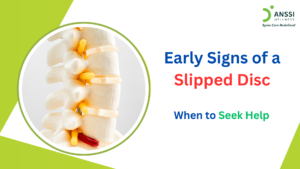When we think about spinal misalignment, most people are familiar with the term spondylolisthesis, which describes a forward slippage of one vertebra over another. But fewer people have heard of retrolisthesis, a lesser-known condition where the slippage occurs in the opposite direction.
Though it’s less common, retrolisthesis can still cause significant discomfort, nerve irritation, and reduced mobility when left unaddressed. So, let’s take a closer look at what retrolisthesis is, the different types of this condition, how it differs from spondylolisthesis, and why early diagnosis and proper care are key to managing symptoms effectively.
What Is Retrolisthesis?
Retrolisthesis is a spinal condition where one vertebra slips backwards in relation to the vertebra directly below it. This backwards slippage can create instability in the spine, placing abnormal stress on spinal joints, discs, and surrounding nerves.
The result may be localised pain, reduced mobility, and, in some cases, radiating nerve symptoms like tingling, numbness, or muscle weakness.
Retrolisthesis is most commonly seen in the cervical (neck) and lumbar (lower back) regions of the spine. It often develops due to age-related disc degeneration, trauma, poor posture, or chronic spinal stress.
Common symptoms of retrolisthesis include:
- Localised neck or back pain
- Muscle stiffness or tightness
- Limited range of motion
- Pain radiating to arms or legs (if nerves are compressed)
- Fatigue or discomfort after standing or walking
In mild cases such as Grade 1 retrolisthesis, symptoms may be subtle. However, if not treated, the condition can become worse over time.
Types of Retrolisthesis
There are several classifications of retrolisthesis, based on the extent and location of the vertebral slippage:
1. Complete Retrolisthesis
This occurs when one vertebra completely slips backwards relative to the vertebra above and below it. It’s more severe and typically associated with higher levels of instability and nerve involvement.
2. Partial Retrolisthesis
This involves a backwards movement, where the vertebra slips backwards relative to the vertebra above or the vertebra below it. Partial retrolisthesis is common in early or mild stages of the condition.
3. Stair-Stepped Retrolisthesis
This occurs when a vertebra slips backwards relative to the vertebra above and stays ahead of the vertebra below it. This pattern often appears in patients with widespread disc degeneration or postural instability.
The severity of retrolisthesis is often graded from Grade 1 to Grade 4, with Grade 1 being the least severe (less than 25% backwards slippage). Early intervention at this stage can prevent the condition from progressing.
Retrolisthesis vs. Spondylolisthesis: What’s the Difference?
It’s easy to confuse retrolisthesis with spondylolisthesis since both involve vertebral misalignment, but the direction of the slippage is what sets them apart.
Retrolisthesis
- Direction of Slippage: Backwards
- Common Locations: Cervical and lumbar spine
- Main Causes: Disc degeneration, trauma, or poor posture
- Symptoms: Back/neck pain, nerve irritation
- Diagnosis: X-ray, MRI, physical exam
Spondylolisthesis
- Direction of Slippage: Forward
- Common Locations: Primarily lumbar spine
- Main Causes: Fractures, congenital defects, repetitive stress
- Symptoms: Lower back pain, leg numbness, weakness
- Diagnosis: X-ray, CT, MRI, neurologic assessment
Retrolisthesis is often linked to disc thinning, where the disc loses its cushioning ability and allows the vertebra to shift backwards. In contrast, spondylolisthesis is frequently associated with a stress fracture or defect in the vertebra (especially in athletes).
Understanding this distinction is crucial because the treatment approach may differ depending on the type and direction of vertebral slippage.
Diagnosis and Assessment
To diagnose retrolisthesis, a spine specialist will typically conduct:
- Physical examination to assess posture, spinal alignment, and range of motion
- X-rays to detect vertebral slippage
- MRI or CT scans to evaluate soft tissues, disc health, and nerve involvement
- Neurological tests if symptoms include numbness or weakness
Once confirmed, the condition is graded based on the percentage of vertebral displacement, which helps guide treatment decisions.
Can Retrolisthesis Be Treated Without Surgery?
Yes, especially in Grade 1 or mild cases, non-surgical care is highly effective. Many patients experience relief and improved mobility with a conservative, multi-approach plan.
Key non-surgical treatments include:
1. Physical Therapy
Custom exercises to strengthen the core, stabilise the spine, and improve flexibility. Posture training also helps reduce daily strain on the vertebrae.
2. Postural Correction
Improving sitting and standing posture helps to reduce pressure on the spine. Ergonomic changes at work and during sleep can make a big difference.
3. Pain Management
Short-term use of anti-inflammatory medicines, muscle relaxants, or ice/heat therapy can help manage acute flare-ups.
4. Non-Surgical Spinal Decompression Treatment (NSSDT)
This gentle treatment involves lying on a specialised decompression table that slowly stretches the spine in a controlled manner. For retrolisthesis caused by disc degeneration or herniation, spinal decompression can help by:
- Creating space between vertebrae
- Reducing nerve pressure
- Improving disc hydration and alignment
- Supporting long-term spinal stability
At ANSSI Wellness, the advanced spinal decompression systems are designed to treat conditions like Grade 1 retrolisthesis without surgery, injections, or medication, offering patients a safe, non-invasive path to relief.
About ANSSI:
ANSSI Wellness focuses on improving the quality of life for patients suffering from spinal issues, aiming to provide relief where other conventional treatments have failed. Through advanced non-surgical spinal decompression treatment, ANSSI is committed to helping patients avoid surgery and recover in a safe, effective, and compassionate environment.
Connect with ANSSI Wellness on LinkedIn, Instagram, and Facebook for expert guidance.




